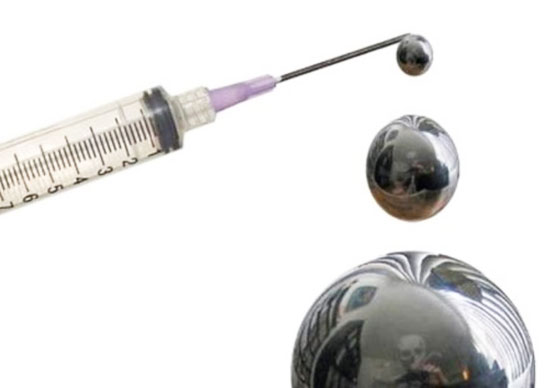50 Vaccine Studies the AAP Failed to Send President Trump (4)
Read the third part of the article
24. Canadian researchers report vaccine aluminium and autism prevalence related
Do aluminum vaccine adjuvants contribute to the rising prevalence of autism?
, J Inorg Biochem. Tomljenovic L, Shaw CA.

“Dysfunctional immunity and impaired brain function are core deficits in ASD. Aluminum (Al), the most commonly used vaccine adjuvant, is a demonstrated neurotoxin and a strong immune stimulator. Hence, adjuvant Al has the potential to induce neuroimmune disorders. The application of the Hill’s criteria to these data indicates that the correlation between Al in vaccines and ASD may be causal. Because children represent a fraction of the population most at risk for complications following exposure to Al, a more rigorous evaluation of Al adjuvant safety seems warranted. By satisfying eight of the Hill’s criteria for establishing causality applicable to our study, we show that Al-adjuvanted vaccines may be a significant etiological factor in the rising prevalence of ASD in the Western world. We also show that children from countries with the highest ASD prevalence appear to have a much higher exposure to Al from vaccines, particularly at 2 months of age.”
25. Harvard researchers find vaccine mercury impacts neurodevelopment in rats
Maternal Thimerosal Exposure Results in Aberrant Cerebellar Oxidative Stress, Thyroid Hormone Metabolism, and Motor Behavior in Rat Pups; Sex- and Strain-Dependent Effects
, Cerebellum, 2012, Z. L. Sulkowski & T. Chen & S. Midha & A. M. Zavacki & Elizabeth M. Sajdel-Sulkowska.
“Our data indicate that maternal TM exposure results in a delayed auditory maturation and impaired motor learning in rat pups. Factors that may contribute to these abnormalities include increased cerebellar oxidative stress and decreased D2 activity resulting local intracerebellar T3 deficiency and altered TH-dependent gene expression. Indeed, provided here is the first evidence of altered TH-dependent gene expression following TM exposure. Our data thus demonstrate a negative neurodevelopmental impact of perinatal TM exposure, which appears to be both strain- and sex-dependent. Although, additional studies are needed, data derived from TM exposure in rats may provide clues relevant to understanding neurodevelopmental consequences of TM exposure in humans.”
26. Suny Stony brook scientists find boys receiving the hepatitis B vaccine series were three times more likely to have autism
Hepatitis B Vaccination of Male Neonates and Autism Diagnosis, NHIS 1997–2002
, Journal of Toxicology and Environmental Health, April 2010, Carolyn Gallagher and Melody Goodman.
“Boys vaccinated as neonates had threefold greater odds for autism diagnosis compared to boys never vaccinated or vaccinated after the first month of life. Findings suggest that U.S. male neonates vaccinated with the hepatitis B vaccine prior to 1999 (from vaccination record) had a threefold higher risk for parental report of autism diagnosis compared to boys not vaccinated as neonates during that same time period.”
27. British and Swedish scientists raise concerns about limited understanding of vaccine aluminium’s impact on the human body, raise risk of autoimmune response
The immunobiology of aluminium adjuvants: how do they really work?
, Trends in Immunology 2010, Christopher Exley, Peter Siesjo, Hakan Eriksson.
“Aluminium adjuvants potentiate the immune response, thereby ensuring the potency and efficacy of typically sparingly available antigen. Their concomitant critical importance in mass vaccination programmes may have prompted recent intense interest in understanding how they work and their safety. Progress in these areas is stymied, however, by a lack of accessible knowledge pertaining to the bioinorganic chemistry of aluminium adjuvants, and, consequently, the inappropriate application and interpretation of experimental models of their mode of action. In relation to this possible ‘indirect adjuvanticity’ there are burgeoning examples in the scientific literature of aluminium salts inducing sensitization to substances that might not normally be considered as antigens. For example, such effects may contribute towards allergies to foods.”
28. Baby monkeys given U.S. vaccine schedule had brain abnormalities in region responsible for social and emotional development
Influence of pediatric vaccines on amygdala growth and opioid ligand binding in rhesus macaque infants: A pilot study
, Acta Neurobiol Exp, 2010, Laura Hewitson, Brian J. Lopresti, Carol Stott.
“The data suggest that vaccine exposure may be associated with significant disturbances in central opioidergic pathways in this model. Volumetric analyses identified significantly greater total brain volume in exposed compared with unexposed animals at both measured time points. These results raise the possibility that multiple vaccine exposures during the previous 3-4 months may have had a significant impact on brain growth and development.”
29. Scientists raise concerns about denial of environmental toxin link to autism, review literature
Sorting out the spinning of autism: heavy metals and the question of incidence
, Acta Neurobiol, 2010 Mary Catherine DeSoto and Robert T. Hitlan.
“In this paper, we argue that increasingly over the past decade, positions that deny a link to environmental toxins and autism are based on relatively weak science and are disregarding the bulk of scientific literature. The question about toxic exposure and autism is open, with the weight of evidence favoring a connection that is not well understood. Although it is not possible to say with certainty, it seems likely that the connection would be mediated by genetic susceptibility and ability to detoxify. That is, some people have genotypes that confer higher susceptibility to toxic exposures. If so, then 50 years ago few people would have had enough toxic exposure to have the neurological changes that result in autism.”
30. Researchers warn of sizable difference in individual reaction to vaccines, stress need to avoid increasing side effects of vaccines
Interindividual variations in the efficacy and toxicity of vaccines
, Toxicology 2010, Thomas C, Moridani M.
“A number of currently available vaccines have shown significant differences in the magnitude of immune responses and toxicity in individuals undergoing vaccination. A number of factors may be involved in the variations in immune responses, which include age, gender, race, amount and quality of the antigen, the dose administered and to some extent the route of administration, and genetics of immune system. Hence, it becomes imperative that researchers have tools such as genomics and proteomics at their disposal to predict which set of population is more likely to be non-responsive or develop toxicity to vaccines. With the increasing number of side effects associated with a number of vaccines reported over the years, it has become imperative to develop new technologies that can effectively assist in the development and evaluation of vaccines for efficacy and toxicity.”
31. Vaccine aluminium injected into mice created significant motor deficits and motor neuron degeneration
Aluminum hydroxide injections lead to motor deficits and motor neuron degeneration
, Journal of Inorg Biochem, February 2010, Christopher A. Shaw, Michael S. Petrik.
“Aluminum-treated mice showed significantly increased apoptosis of motor neurons and increases in reactive astrocytes and microglial proliferation within the spinal cord and cortex. Morin stain detected the presence of aluminum in the cytoplasm of motor neurons with some neurons also testing positive for the presence of hyper-phosphorylated tau protein, a pathological hallmark of various neurological diseases, including Alzheimer’s disease and frontotemporal dementia. A second series of experiments was conducted on mice injected with six doses of aluminum hydroxide. Behavioural analyses in these mice revealed significant impairments in a number of motor functions as well as diminished spatial memory capacity. The demonstrated neurotoxicity of aluminum hydroxide and its relative ubiquity as an adjuvant suggest that greater scrutiny by the scientific community is warranted. Overall, the results reported here mirror previous work that has clearly demonstrated that aluminum, in both oral and injected forms, can be neurotoxic.”
32. Newborn monkeys given a mercury-containing Hepatitis B vaccine had significant delays in neonatal reflexes and neurological development

Delayed acquisition of neonatal reflexes in newborn primates receiving a thimerosal-containing Hepatitis B vaccine: Influence of gestational age and birth weight
, Neurotoxicology, Sep 2009 Laura Hewitson et. al.
“In summary, this study provides preliminary evidence of abnormal early neurodevelopmental responses in male infant rhesus macaques receiving a single dose of Th-containing HB vaccine at birth and indicates that further investigation is merited.”
33. French scientists report aluminium from vaccines causes chronic cognitive dysfunction
Long-term persistence of vaccine-derived aluminum hydroxide is associated with chronic cognitive dysfunction
, Journal of Inorganic Biochemistry, 2009, Couette M1, Boisse MF, Maison P, Brugieres P, Cesaro P, Chevalier X, Gherardi RK, Bachoud-Levi AC, Authier FJ.
“In conclusion, long-term persistence of vaccine-derived aluminum hydroxide within the body assessed by MMF is associated with cognitive dysfunction, not solely due to chronic pain, fatigue and depression. In conclusion, this work is the first firm demonstration that cognitive dysfunction is a central feature in MMF, this dysfunction being much more frequent and severe than suspected by routine neurological evaluation. Instead of being a non-specific bystander effect of pain, fatigue or depression, MACD seems to reflect an underlying organic, inflammatory or toxic, brain involvement.”
34. Swedish researchers found that children who had natural measles infection had much lower rates of allergy than children vaccinated against measles
Allergic Disease and Atopic Sensitization in Children in Relation to Measles Vaccination and Measles Infection
, Pediatrics 2009 Rosenlund H1, Bergstrom A, Alm JS, Swartz J, Scheynius A, van Hage M, Johansen K, Brunekreef B, von Mutius E, Ege MJ, Riedler J, Braun-Fahrlander C, Waser M, Pershagen G; PARSIFAL Study Group.
“However, in these analyses, measles infection [natural measles] was inversely associated with any allergic symptom or physician’s diagnosis of allergy.”
35. Boys receiving the Hepatitis B vaccine series were nine times for likely to need special education and be developmentally disabled
Hepatitis B triple series vaccine and developmental disability in US children aged 1–9 years
, Toxicological and Environmental Chemistry, September 2008, Carolyn Gallagher and Melody Goodman.
“This study investigated the association between vaccination with the Hepatitis B triple series vaccine. The odds of receiving Special Education were approximately nine times as great for vaccinated boys (n 1/4 46) as for unvaccinated boys (n 1/4 7), after adjustment for confounders. This study found statistically significant evidence to suggest that boys in United States who were vaccinated with the triple series Hepatitis B vaccine, were more susceptible to developmental disability than were unvaccinated boys.”
36. Children who delayed the timing of the DPT vaccine had lower rates of asthma
Delay in diphtheria, pertussis, tetanus vaccination is associated with a reduced risk of childhood asthma?
, Journal of Allergyand Clinical Immunology, 2008, Kara L. McDonald, MS, Shamima I. Huq, BS.
“Early childhood immunizations have been viewed as promoters of asthma development by stimulating a T(H)2-type immune response or decreasing microbial pressure, which shifts the balance between T(H)1 and T(H)2 immunity. Among 11, 531 children who received at least 4 doses of DPT, the risk of asthma was reduced to (1/2) in children whose first dose of DPT was delayed by more than 2 months.”
37. A CDC sponsored database showed much higher rates of neurodevelopmental disabilities from mercury containing vaccines
Thimerosal exposure in infants and neurodevelopmental disorders: An assessment of computerized medical records in the Vaccine Safety Datalink
, Journal of the Neurological Sciences, March 2008, Heather A. Young, David A. Geier, Mark R. Geier.
“Consistent significantly increased rate ratios were observed for autism, autism spectrum disorders, tics, attention deficit disorder, and emotional disturbances with 4Hg exposure from TCVs. By contrast, none of the control outcomes had significantly increased rate ratios with Hg exposure from TCVs.”
Read the fifth part of the article
yogaesoteric
April 12, 2019
